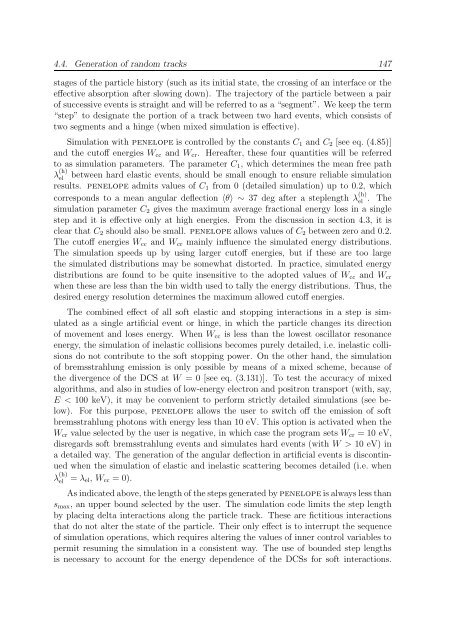PENELOPE 2003 - OECD Nuclear Energy Agency
PENELOPE 2003 - OECD Nuclear Energy Agency
PENELOPE 2003 - OECD Nuclear Energy Agency
You also want an ePaper? Increase the reach of your titles
YUMPU automatically turns print PDFs into web optimized ePapers that Google loves.
4.4. Generation of random tracks 147<br />
stages of the particle history (such as its initial state, the crossing of an interface or the<br />
effective absorption after slowing down). The trajectory of the particle between a pair<br />
of successive events is straight and will be referred to as a “segment”. We keep the term<br />
“step” to designate the portion of a track between two hard events, which consists of<br />
two segments and a hinge (when mixed simulation is effective).<br />
Simulation with penelope is controlled by the constants C 1 and C 2 [see eq. (4.85)]<br />
and the cutoff energies W cc and W cr . Hereafter, these four quantities will be referred<br />
to as simulation parameters. The parameter C 1 , which determines the mean free path<br />
between hard elastic events, should be small enough to ensure reliable simulation<br />
results. penelope admits values of C 1 from 0 (detailed simulation) up to 0.2, which<br />
corresponds to a mean angular deflection 〈θ〉 ∼ 37 deg after a steplength λ (h)<br />
el . The<br />
simulation parameter C 2 gives the maximum average fractional energy loss in a single<br />
step and it is effective only at high energies. From the discussion in section 4.3, it is<br />
clear that C 2 should also be small. penelope allows values of C 2 between zero and 0.2.<br />
The cutoff energies W cc and W cr mainly influence the simulated energy distributions.<br />
The simulation speeds up by using larger cutoff energies, but if these are too large<br />
the simulated distributions may be somewhat distorted. In practice, simulated energy<br />
distributions are found to be quite insensitive to the adopted values of W cc and W cr<br />
when these are less than the bin width used to tally the energy distributions. Thus, the<br />
desired energy resolution determines the maximum allowed cutoff energies.<br />
λ (h)<br />
el<br />
The combined effect of all soft elastic and stopping interactions in a step is simulated<br />
as a single artificial event or hinge, in which the particle changes its direction<br />
of movement and loses energy. When W cc is less than the lowest oscillator resonance<br />
energy, the simulation of inelastic collisions becomes purely detailed, i.e. inelastic collisions<br />
do not contribute to the soft stopping power. On the other hand, the simulation<br />
of bremsstrahlung emission is only possible by means of a mixed scheme, because of<br />
the divergence of the DCS at W = 0 [see eq. (3.131)]. To test the accuracy of mixed<br />
algorithms, and also in studies of low-energy electron and positron transport (with, say,<br />
E < 100 keV), it may be convenient to perform strictly detailed simulations (see below).<br />
For this purpose, penelope allows the user to switch off the emission of soft<br />
bremsstrahlung photons with energy less than 10 eV. This option is activated when the<br />
W cr value selected by the user is negative, in which case the program sets W cr = 10 eV,<br />
disregards soft bremsstrahlung events and simulates hard events (with W > 10 eV) in<br />
a detailed way. The generation of the angular deflection in artificial events is discontinued<br />
when the simulation of elastic and inelastic scattering becomes detailed (i.e. when<br />
λ (h)<br />
el = λ el , W cc = 0).<br />
As indicated above, the length of the steps generated by penelope is always less than<br />
s max , an upper bound selected by the user. The simulation code limits the step length<br />
by placing delta interactions along the particle track. These are fictitious interactions<br />
that do not alter the state of the particle. Their only effect is to interrupt the sequence<br />
of simulation operations, which requires altering the values of inner control variables to<br />
permit resuming the simulation in a consistent way. The use of bounded step lengths<br />
is necessary to account for the energy dependence of the DCSs for soft interactions.
















